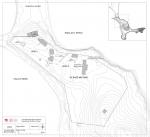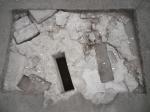Summary (English)
In recent years, Padova University has begun new excavations in a sector of the suburban and extra-urban space of Nora, already known to archaeologists following the discovery of part of a pre-Roman necropolis during excavations in the late 19th – early 20th century.
The Punic hypogea tombs were first discovered in 1871. The largest number came to light between 1891-1892, when F. Nissardi’s excavations led to the discovery of 40 burial chambers and their rich grave goods. A single cremation was found, in a stone cist made of sandstone slabs that also contained a tomb group made up of ceramic vases dating to the late 7th century B.C. Other burials dating to the archaic and Punic periods were found more recently (2011) during work to check for the presence of archaeological remains just north of the perimeter fence of the ex-military base.
Padova University’s renewal of research in the area involved a series of geophysical surveys in 2012 and 2013, followed by the first excavations in 2014, in the central part of the ex-military base, where the remains of an extra-urban road system and several monumental complexes of Roman date were identified.
In a second phase, the research concentrated in the area west of the guardhouse (now a bar-restaurant). Here the morphology of the peninsula is marked by the presence of a small, pronounced hillock (c. 5 m a.s.l.) that closes the sandy isthmus of S. Efisio just beyond its narrowest point. It was decided to concentrate the investigations along the regular and open slope that from the hillock on which the guardhouse stands leads to the ex-naval dock and the small fishing harbour. Evidence of a Phoenician and Punic funerary complex was identified, which however remains unknown and of extraordinary interest.The archaeological control was made by opening a 5 × 5 m trench along the central part of the slope (gradient c. 9%) that led from the guardhouse down to the sea, in correspondence with one of the many areas where the georadar survey showed anomalies. The bedrock appeared at just a few centimetres below the ground surface, constituted by the characteristic Tyrrhenian sandstone known as “panchina”, formed by sands and weakly-cemented bioclasts with a typical horizontally stratified sedimentation. Several regular geometric cuts were identified in the bedrock surface. Three had an elongated rectangular shape, with a uniform length of c. 2.2 m and width of 0.7 m. They were revealed to be access wells to Punic hypogean tombs, the covering slabs missing. The fill was removed from one of the cuts, showing it to be the entrance to a rock-cut chamber tomb. Although not completed during the first campaign, the excavation documented the tomb’s plan. The entrance was identical in length and alignment to the first underground chamber to which it led. The chamber was a quadrangular trapezoid shape and its maximum side measurements were 2.73 m and 2.31 m. A small hatch opened in one of the short walls, on the same access as the entrance well, which led into a second chamber with the same shape and maximum side measurements of 2.40 m and 2.09 m. The floor level has yet to be reached. The layers forming the fill excavated to date were constituted by uniform dumps datable to the mid imperial period (3rd century A.D.), and the removal of the cover slabs and violation of the tomb probably date to this period. In addition to the three rectangular cuts, other quadrangular cuts were identified whose dimensions were not checked as they extended beyond the trench, but they were probably similar to the others or even larger. The covers were still in situ, formed by large parallelepiped sandstone blocks sunk into the cuts. Another cut, also an access well to an underground tomb, was without its cover. Rectangular with one curved side, the maximum dimensions were 0.72 × 0.50 m and it was filled during the Roman period. In addition to the chamber tombs, which can probably be attributed to the Punic period, the excavations identified a much earlier funerary use of the area in the same space. Indeed, at least two cremation burials with grave goods constituted by pottery vessels, which had been deliberately cut off at various heights, were identified in clefts in the bedrock. These burials appeared to have been placed in shallow cuts and then probably covered by heaps of earth or stones that were no longer preserved due to subsequent use and levelling of the area. The finds are presently being studied in collaboration with the CNR – Institute of Ancient Mediterranean Studies and have provided evidence that dates at least one of the burials to within the 7th century B.C.
As the excavation is in an early phase, it is not possible to comment further on the substantial and complex funerary evidence identified or on its chronological-cultural context. However, it appears certain that this is a substantial second nucleus of Punic underground tombs, which can flank the nucleus investigated in 1891-1892 and almost certainly identifiable as the “west group” noted by Patroni and indicated as that from which some of the most important ceramic tomb groups came. No less important is having identified in the same sector traces of a much earlier cemetery linked to the Phoenician centre, so far only known through scarce and difficult to interpret evidence, which may help to establish a very long continuity of use of the space for the same purpose.
- Jacopo Bonetto
Director
Team
Research Body
- Università degli Studi di Padova, Dipartimento dei Beni Culturali






![Download [PDF]](/excavation/skins/fasti/images/results/download_sml.png)

